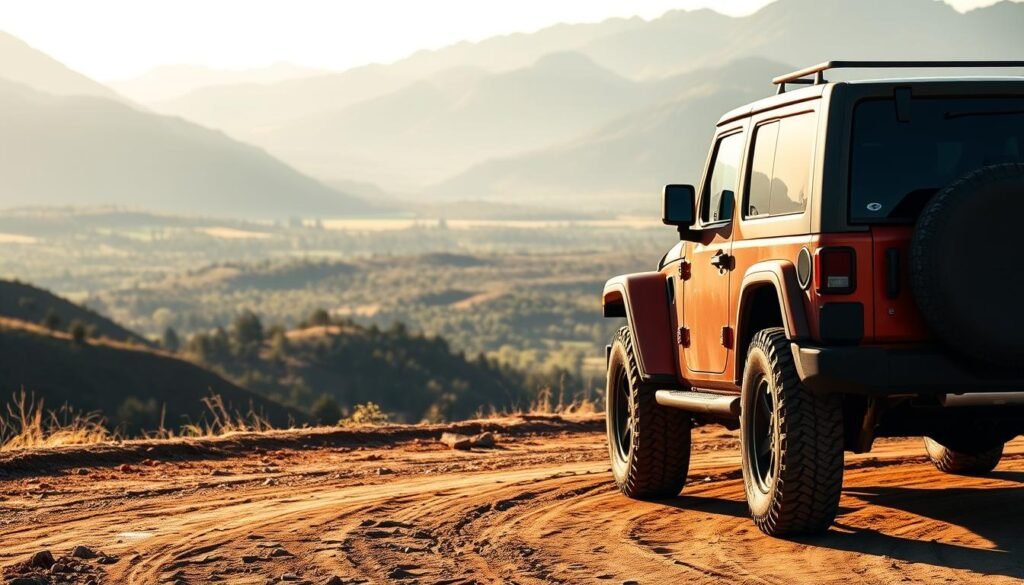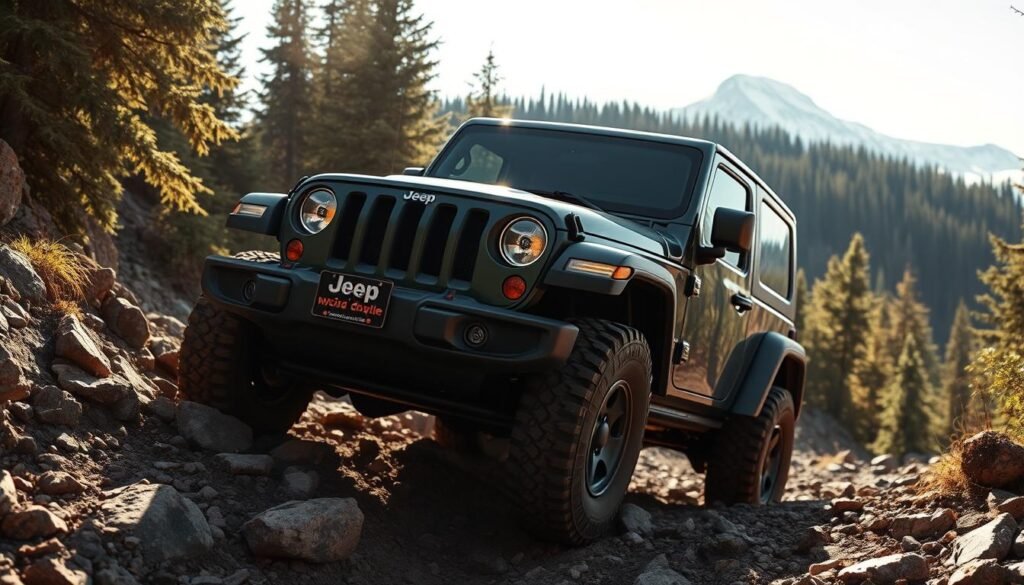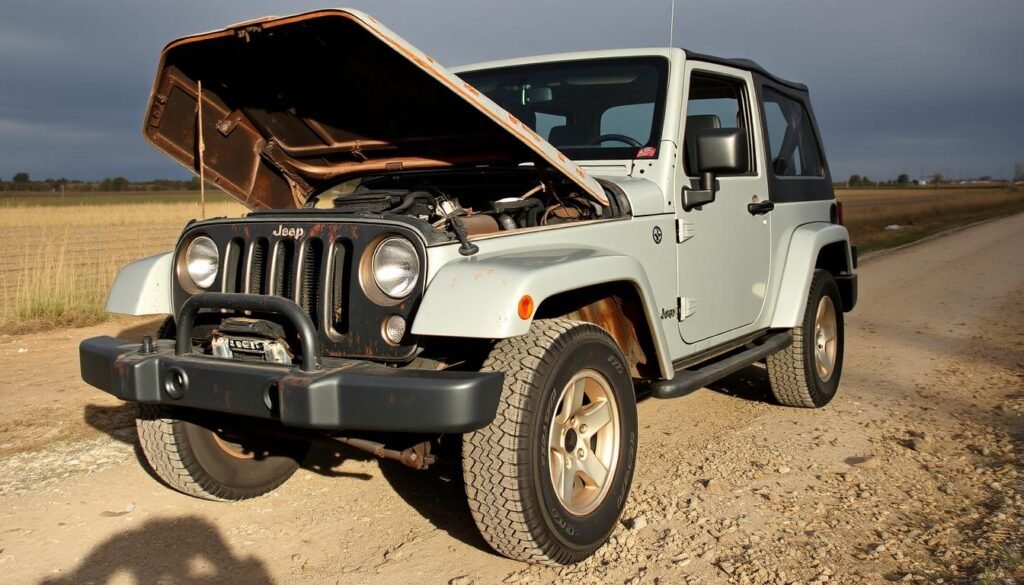Did you know a Jeep Wrangler can handle 34 inches of water? It’s not just for rough terrain; it’s also built for long trips. A full tank in a four-door Wrangler with a 3.6-liter engine can last up to 387 miles.
Jeep Wrangler’s fuel efficiency depends on the model. The two-door 2025 Wrangler with a 3.6-liter engine goes about 332 miles on its 17.5-gallon tank. This is perfect for a weekend or a week of city driving. But what if you’re going further? Let’s explore what affects your Wrangler’s range.
Jeep Wrangler’s Fuel Tank Capacity
Jeep Wrangler fuel tanks are made to handle off-road adventures and long trips. Let’s dive into the Wrangler’s fuel system to plan your adventures better.
Standard Tank Size Specifications
The Jeep Wrangler’s fuel tank can hold 19 gallons. This lets you go on long trips and off-road adventures without needing to stop for gas too often. But, the usable fuel volume might be a bit less.
Actual Usable Fuel Volume
Even though the tank can hold 19 gallons, you can only put in about 16 gallons when the fuel light comes on. This is because of the reserve fuel and to keep air out of the system.
Fuel Gauge Accuracy and Reserve Capacity
Jeep Wrangler fuel gauges have a built-in reserve. Many drivers say their fuel light turns on when they have about 5 gallons left. This reserve gives you an extra 40 to 60 miles, depending on how you drive and the conditions.
| Fuel Tank Aspect | Specification |
|---|---|
| Total Capacity | 19 gallons |
| Typical Refill Amount | 16 gallons |
| Reserve Capacity | ~5 gallons |
| Miles After Fuel Light | 40-60 miles |
Knowing these details about the fuel tank helps Wrangler owners understand their vehicle’s range. This way, they can plan when to refuel better. Remember, how far you can go depends on your driving, any changes to the vehicle, and your driving style.
How Many Miles Can a Jeep Wrangler Go on a Full Tank
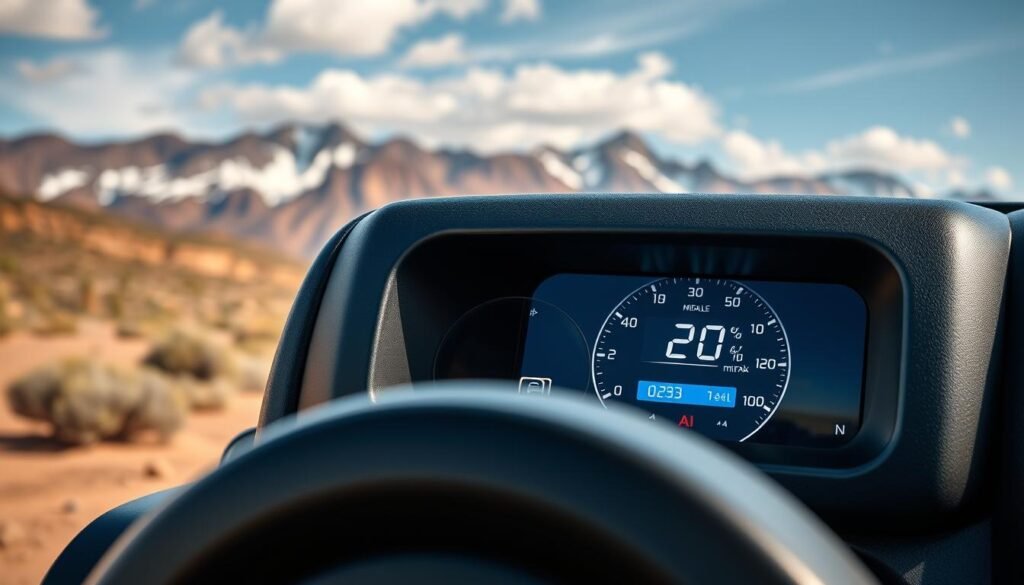
The Jeep Wrangler’s range on a full tank depends on several factors. These include the model year, engine type, and driving conditions. Let’s look at the Jeep Wrangler’s fuel efficiency and miles per tank for different setups.
The 2023 Jeep Wrangler has a 21.5-gallon fuel tank for 4-door models. The 2-door versions have a 17.5-gallon tank. Under ideal conditions, the maximum driving range can reach up to 516 miles.
| Model | City MPG | Highway MPG | Combined MPG |
|---|---|---|---|
| Willys Sport, Sport S, Freedom, Rubicon (4-door) | 17 | 23 | 19 |
| Sahara, Sport RHD, High Altitude | 21 | 24 | 22 |
| Rubicon 392 | 13 | 17 | 15 |
Real-world driving ranges can vary. The 3.6L V6 engine and eight-speed automatic in 4-door models can go up to 516 miles per tank. The 2.0L Turbo engine in the Sahara trim also reaches this range. The high-performance Rubicon 392, though, gets around 365.5 miles per tank.
The plug-in hybrid 4xe powertrain offers a 370-mile range when fully charged and fueled. This shows the Wrangler’s evolving fuel efficiency options. It caters to various driving needs and preferences.
Factors Affecting Jeep Wrangler’s Fuel Economy
Several key elements affect a Jeep Wrangler’s fuel economy. Knowing these can help improve your vehicle’s performance and efficiency.
Tire Size Impact on Mileage
Larger tires can greatly reduce a Wrangler’s fuel efficiency. They offer better off-road performance but increase rolling resistance and weight. For example, switching from 31-inch to 35-inch tires can cut MPG by 2-3 points.
Gear Ratio Considerations
Gear ratios are vital for a Jeep Wrangler’s fuel economy. Lower gears give more power but use more fuel. Higher gears improve highway driving but may not work well off-road. Finding the right balance is crucial for best performance and fuel economy.
Driving Conditions and Terrain
The environment greatly affects fuel consumption. City driving with frequent stops can drop efficiency to around 18 MPG. Highway cruising can reach up to 24 MPG. Off-road adventures in tough terrain can significantly lower fuel economy.
Vehicle Modifications Effect
Modifications like lift kits, heavy bumpers, and roof racks can harm aerodynamics and increase weight, reducing fuel efficiency. Yet, some upgrades, like cold air intakes, can boost MPG by 1-2 points. It’s important to think about the fuel economy impact when making modifications.
| Modification | Fuel Economy Impact |
|---|---|
| 35-inch Tires | -2 to -3 MPG |
| Lift Kit | -1 to -2 MPG |
| Cold Air Intake | +1 to +2 MPG |
| Hard Top (vs Soft Top) | +1 MPG |
Real-World Mileage Reports from Wrangler Owners
Jeep Wrangler owners report a wide range of mileage. A study of 6,461 Wranglers, covering 118 million miles, shows interesting trends. The 2024 models average 18.6 MPG, while 2015 models average 16 MPG. This data comes from thousands of fuel-ups and miles driven by actual owners.
Newer Wranglers are more fuel-efficient. The 2023 models average 19.1 MPG, and 2021 models average 19.3 MPG. Older models from the early 2000s average 14-15 MPG. The lowest average is 12 MPG for 1990 Wranglers.
Individual Jeep Wrangler owner experiences can vary a lot. Some owners report up to 25 MPG on flat roads at lower speeds. Driving habits, terrain, and modifications greatly affect real-world mileage.
| Year | Average MPG | Vehicles | Miles Tracked |
|---|---|---|---|
| 2024 | 18.6 | 171 | 1,002,509 |
| 2020 | 18.6 | 197 | 3,822,835 |
| 2015 | 16.0 | 472 | 12,130,073 |
| 2010 | 15.5 | 206 | 4,629,107 |
| 2005 | 13.9 | 202 | 2,963,901 |
These reports show how the Wrangler’s fuel efficiency has improved over time. While newer models are better, individual results can vary. Owners should use these reports to estimate their Wrangler’s fuel consumption.
Highway vs City Driving Range Differences
The Jeep Wrangler’s fuel efficiency changes a lot between driving on highways and in the city. Knowing these differences helps owners get the most out of their vehicle. It also makes planning trips easier.
Highway Driving Performance
On highways, the Jeep Wrangler does great with its highway mpg. The Wrangler Unlimited Sport gets 24 MPG on highways, beating its city mileage. The 3.0-liter turbodiesel V6 engine does even better, reaching 29 MPG on the highway. This makes it perfect for long trips.
Urban Driving Statistics
In the city, fuel efficiency is harder to achieve. The two-door Wrangler gets 20 MPG in urban areas. The Unlimited Sport gets 19 MPG. These numbers show how city driving, with its stops and idling, affects fuel use.
Combined Driving Range Estimates
Looking at combined driving range gives a full picture. The Wrangler Unlimited Sport averages 21 MPG in mixed driving. The 2.0L turbocharged engine with an eight-speed automatic gets 22 MPG combined. For the best efficiency, the Wrangler 4xe plug-in hybrid is a top choice, with 49 MPGe.
| Driving Condition | Wrangler Unlimited Sport MPG | Turbodiesel V6 MPG |
|---|---|---|
| City | 19 | 22 |
| Highway | 24 | 29 |
| Combined | 21 | 25 |
Fuel Light Warnings and Remaining Range
Knowing when your Jeep Wrangler’s fuel light turns on can prevent unexpected stops. We’ll explore when this happens and how far you can drive afterward.
When Does the Fuel Light Activate
The fuel light in your Jeep Wrangler lights up when about 2.8 gallons of fuel are left. This alert tells you when it’s time to fill up before you run out.
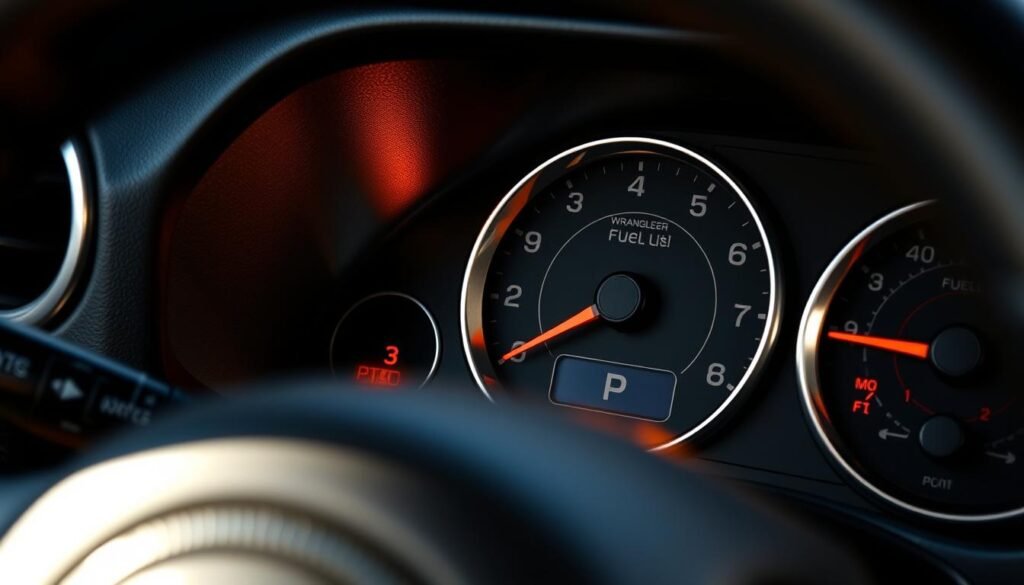
Safe Driving Distance After Warning
After the fuel light turns on, you can drive about 47-58 miles before needing gas. This distance can change based on how you drive, the terrain, and your vehicle’s specifics.
The estimate on your dashboard might change. It often stops counting at 25 miles and shows a “Low Fuel” warning. This is because estimates can be off when you’re almost out of gas.
| Vehicle | Miles Remaining After Fuel Light |
|---|---|
| Jeep Wrangler | 47-58 |
| Ford F-150 | 35-80 |
| Toyota Camry | 65-91 |
| Honda Accord | 70-93 |
It might be tempting to keep driving when the light comes on. But driving on low fuel can wear out your fuel pump. To keep your Jeep Wrangler running well, fill up before the light turns on.
Calculating Accurate MPG for Modified Wranglers
Figuring out your modified Jeep Wrangler’s fuel efficiency is important. Different modifications can change how much fuel your vehicle uses. It’s key to know how to accurately measure your modified Jeep Wrangler’s mpg.
When you add bigger tires, your odometer might not show the right distance. This can make your mpg calculations off. To fix this, use GPS or mile markers to find the real distance you’ve traveled.
- Fill up your tank completely
- Reset your trip odometer
- Drive normally until you need to refuel
- Fill up again, noting the number of gallons added
- Record the trip odometer reading
- Divide miles traveled by gallons used
Remember, things like where you drive, the terrain, and how you drive can change your Wrangler’s fuel use. For better results, do this a few times and then average the numbers.
| Modification | Potential MPG Impact |
|---|---|
| Larger Tires | -1 to -3 mpg |
| Lift Kit | -1 to -2 mpg |
| Heavy Bumpers | -0.5 to -1 mpg |
| Roof Rack | -0.5 to -1 mpg |
By knowing these factors and using the right methods, you can really understand your modified Jeep Wrangler’s fuel use. This info helps you make smart choices about future changes and how you drive. It’s all about getting the most out of your vehicle.
Tips to Maximize Fuel Range in Your Wrangler
Want to get more miles from your Jeep Wrangler’s fuel tank? Here are some tips to help you save money and go further.
Driving Techniques for Better Efficiency
Slow down when you start moving to save up to 20% on fuel. Don’t idle for more than 7 seconds, as it’s a waste. If you have a 2024 Jeep Wrangler 4xe, use its regenerative braking to save energy.
Maintenance Practices
Make sure your tires are at the right pressure, 37 psi for a Wrangler JL. Low tire pressure can cut fuel efficiency by 3% for every psi drop. Check tire pressure often, as it changes with temperature.
Modification Considerations
For better fuel efficiency, keep modifications simple. Losing 100 pounds can improve fuel economy by 1-2%. Remove roof racks when not needed to avoid wind resistance. These tips can help your Wrangler go 300-400 miles per tank, making trips more affordable and fun.
FAQ
What is the average fuel tank capacity of a Jeep Wrangler?
A Jeep Wrangler usually has a fuel tank that holds about 21.5 gallons. But, the exact amount can change based on the model and year.
How many miles can a Jeep Wrangler go on a full tank of gas?
On average, a Jeep Wrangler can travel between 350 to 400 miles on a full tank. But, this can change a lot based on how you drive and the terrain.
Does tire size affect the fuel efficiency of a Jeep Wrangler?
Yes, the size of your tires can really affect how much gas your Jeep Wrangler uses. Bigger tires use more gas because they’re harder to turn and need more power.
How does highway driving compare to city driving in terms of fuel efficiency for a Jeep Wrangler?
Jeep Wranglers usually get better gas mileage on highways than in the city. This is because highways have steady speeds and fewer stops, which helps save gas.
When does the fuel light typically come on in a Jeep Wrangler?
The fuel light in a Jeep Wrangler turns on when there’s about 2 to 3 gallons left. This means you have around 30-50 miles left, depending on how you drive.
How can I calculate accurate MPG for my modified Jeep Wrangler?
To get an accurate MPG for your modified Wrangler, you need to consider changes like bigger tires. Keep track of how far you go between fill-ups. Then, divide that by how much gas you use. Do this a few times to get the most accurate reading.
What are some tips to maximize fuel range in a Jeep Wrangler?
To get the most out of your Wrangler’s gas, drive at steady speeds, avoid sudden stops and starts, and keep your tires at the right pressure. Also, remove extra weight, stay on top of maintenance, and use cruise control on highways.
How do gear ratios affect a Jeep Wrangler’s fuel economy?
Gear ratios play a big role in how much gas your Wrangler uses. Lower gear ratios help with acceleration but use more gas. Higher gear ratios help save gas, which is good for highway driving.
Can vehicle modifications improve my Jeep Wrangler’s fuel efficiency?
Some modifications can actually make your Wrangler use less gas. For example, a cold air intake or a performance chip might help. But, always check the effects of any changes before you make them, as results can vary.
